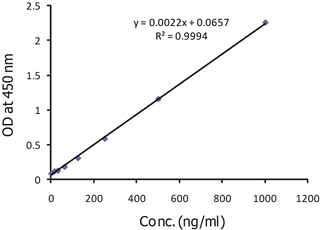BAFF Soluble (human) Matched Pair Detection Set
Product Code:
AG-46B-0001
Application:
Enzyme-Linked Immunosorbent Assay (ELISA)
No additional charges, what you see is what you pay! *
Stay in control of your spending. These prices have no additional charges, not even shipping!
* Rare exceptions are clearly labelled (only 0.14% of items!).
Multibuy discounts available!
Contact us to find what you can save.
This product comes from:
Switzerland.
Typical lead time:
7-10 working days.
Contact us for more accurate information.
- Further Information
- Documents
- References
- Show All
Further Information
Alternate Names/Synonyms:
BlyS; B Cell Activating Factor
Sandwich
Colorimetric
32160000
Avoid freeze/thaw cycles.
1 vial standard protein (5µg) (lyophilized) [STD] | 1 vial coating antibody (120µl) [COAT] | 1 vial detection antibody (60µl) [DET] | 1 vial streptavidin-HRP (10µg) (lyophilized) [STREP]
Matched Pair Detection Set. Detects human BAFF. Does not detect mouse BAFF. Colorimetric assay. Sample Types: Cell Culture Supernatant, Plasma, Serum. Range: 16 to 1000pg/ml. Sensitivity: 16pg/ml. BAFF (B cell-activating factor; BLyS; B lymphocyte stimulator; TNFSF13B; TALL-1; CD257), belonging to the TNF family, is a master regulator of peripheral B cell survival, and together with IL-6, promotes Ig class-switching and plasma cell differentiation. BAFF co-stimulates activated T cells. Increased levels of soluble BAFF have been detected in the serum of patients with various autoimmune diseases, such as Sjögren?s syndrome, rheumatoid arthritis, multiple sclerosis and systemic lupus erythematosus (SLE). Furthermore, BAFF is found in inflammatory sites in which there is lymphoid neogenesis. BAFF levels are elevated in patients with multiple myeloma and B cell chronic lymphoid leukemia (B-CCL).
Q5H8V1
Box
BAFF (B cell-activating factor; BLyS; B lymphocyte stimulator; TNFSF13B; TALL-1; CD257), belonging to the TNF family, is a master regulator of peripheral B cell survival, and together with IL-6, promotes Ig class-switching and plasma cell differentiation. BAFF co-stimulates activated T cells. Increased levels of soluble BAFF have been detected in the serum of patients with various autoimmune diseases, such as Sjögren?s syndrome, rheumatoid arthritis, multiple sclerosis and systemic lupus erythematosus (SLE). Furthermore, BAFF is found in inflammatory sites in which there is lymphoid neogenesis. BAFF levels are elevated in patients with multiple myeloma and B cell chronic lymphoid leukemia (B-CCL).
16 to 1000pg/ml
Cell Culture Supernatant, Plasma, Serum
16pg/ml
Detects human BAFF. Does not detect mouse BAFF.
Non-hazardous
ELISA Kits
41116126
Stable for at least 1 year after receipt when stored at -20°C.



